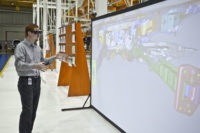What do you get when you take an iconic American car from the 1960s, mix in some contemporary Italian flair, and then add a fresh dose of lean logic? The answer is a reborn Chrysler factory 90 miles northwest of Chicago.
This month, the 47-year-old Belvidere Assembly Plant is ramping up production of the 2013 Dodge Dart. It’s the first Chrysler Group LLC vehicle that is the offspring of its 2009 union with Fiat S.p.A.
The four-door compact sedan is built on the same platform as the Alfa Romeo Giulietta hatchback. However, the Dart is 12 inches longer and 1 inch wider to appeal to American consumers. The platform-sharing strategy is a key part of Fiat’s plan to improve operating efficiencies and boost volume in North America.
The Dart is Chrysler Group’s first compact sedan since it stopped making the Dodge Neon in 2005. It replaces the Dodge Caliber, which was also previously built in the Belvidere plant (the last vehicle rolled off the line in December 2011). The Dart will compete against the Chevy Cruze, Ford Focus, Honda Civic, Hyundai Elantra and Toyota Corolla.
Chrysler decided to resurrect a nameplate that hasn’t been used since 1976. Back in the 1960s, the Dodge Dart was a popular car that competed against the AMC Rambler, Chevy II Nova, Ford Falcon and Volkswagen Beetle. More than 4 million Darts were built between 1960 and 1976. In the late 1960s and early 1970s, the Dart was a “muscle car” popular with hot rodders and street racers.
Today’s version of the Dart is being marketed as a fuel-efficient, fun-to-drive vehicle. Besides sharing stylish Alfa Romeo DNA, it boasts a fuel economy rating of 40 mpg, 10 airbags and the same 8.4-inch infotainment screen that’s in the Chrysler 300 luxury sedan. The Dart is available in five trim levels: SE, SXT, Rallye, Limited and R/T.
The vehicle is designed to be personalized by buyers to fit their individual tastes. In fact, consumers can choose 12 exterior colors, 14 interior color and trim combinations, six wheel options, four grills, three engine options and three transmissions.
Flexible Production
That high level of customization demands a flexible production process. Indeed, the Dart is being built on the same assembly line that builds the Jeep Compass and Jeep Patriot sport utility vehicles.
Fiat recently invested $700 million in the Belvidere plant to ensure that flexibility. “The Dart is a groundbreaking new car,” claims Sergio Marchionne, chairman and CEO of Chrysler Group, who also serves as CEO of Fiat. “It was not by chance that we chose Belvidere to make this investment. We are creating a work environment that is dedicated to quality and with the flexibility to compete with the best plants anywhere in the world.
“Belvidere continues to shine among our top performers and this plant is being benchmarked against our European [facilities],” adds Marchionne. “[This plant] is an example of the kind of mosaic we aim to create between our two companies, Chrysler and Fiat.”
The Dart is the 22nd different vehicle to be built in the 5 million square foot Belvidere plant, which originally assembled full-sized station wagons such as the 1965 Plymouth Fury. Chrysler is hiring 1,800 new employees at the plant, which includes the addition of a third shift and hundreds of assemblers to build the Dart.
The new operators will be using an innovative 3-2-120 work pattern, which will allow the plant to run an additional 49 days per year. “The 3-2-120 schedule utilizes three crews, working four 10-hour straight-time days per week for a total of 120 hours of production time,” says Scott Garberding, senior vice president of manufacturing at Chrysler Group.
“A typical two-shift schedule provides 80 hours per week of production time,” Garberding points out. “Compared to a traditional plant schedule, individual employees on a 3-2-120 schedule will work 49 fewer days per year, but the plant will operate 49 more days.”
Fiat’s lean manufacturing initiative, which it calls World Class Manufacturing (WCM), will play a critical role in the new Belvidere assembly strategy. “Fiat began developing, implementing and refining the WCM methodology in 2005 with the purpose of reducing waste, increasing productivity and restoring dignity to the employees,” says Massimo Risi, head of World Class Manufacturing at Chrysler Group.
As a result of the collaboration with Fiat and the sharing of knowledge, WCM has become the driving force behind the improvements in all Chrysler assembly plants. Last year, Belvidere employees submitted more than 20,000 suggestions because of the WCM initiative. “They implemented more than 3,400 projects that have a potential annualized savings of $32 million,” claims Garberding
“When Chrysler was developing its survival plan in partnership with Fiat in 2009, one of the key elements of turning the company around was the implementation of WCM,” adds Garberding. “Now, after two and a half years, our manufacturing facilities are some of the most productive and efficient in the industry.”
The WCM system consists of 10 technical and 10 managerial
pillars, each with incremental levels of
improvement. Results are clearly identified and measurable. The retooled Belivedere plant features a WCM communications center located near the entrance. It allows all assemblers to track metrics related to quality control, workplace organization and other WCM pillars.
New Assembly Equipment
Fiat installed new machinery, tooling and material handling equipment exclusively for assembling the Dodge Dart. The highlight is a new 638,000 square foot body shop. It includes a metrology center and a center for technical vehicle validation—the first facility of its kind in a Chrysler Group plant—to ensure that the Dart launches with the highest quality possible.
The body shop features hundreds of welding robots and state-of-the-art automation from Comau, a Fiat subsidiary. Some of the robots were relocated from a former Chrysler plant in St. Louis. The body shop also features new pedestal-mounted robots that hang above workstations and contain internal wiring to streamline operations.
Comau technology adapted from a Fiat plant in Europe is used in the new facility to attach the roof and side apertures of the Dart. And, a new material handling system increases horizontal dolly delivery and improves flow. Body parts are delivered to the assembly line on two sides of a triangle-shaped cart. There are 278 new part numbers used in the body shop to produce the Dart.
Although there are two body shops at the Belvidere plant, there’s only one final assembly line. Fiat engineers made changes to the line to accommodate the Dart’s unique architecture.
For example, more workstations were added on the chassis line to facilitate the installation of the Dart’s front end module, which comes to the plant already assembled and is installed later in the process. “As a result, line operators can work in the engine compartment without having to navigate the front end module or bending underneath the vehicle, as they have to do with the Jeep Compass and Patriot,” says Garberding.
At one point on the line, the conveyor automatically positions vehicles at a 45-degree left angle. This allows operators to work on the front and rear of a vehicle at the same time while standing on opposite sides of the assembly line.
“The installation of the instrument panel was another area of the line that required change because of the unique requirements of the Dart,” says Garberding. “[Our engineers] tried to commonize the instrument panel installation arm with the Compass and Patriot, but couldn’t find an appropriate solution. As a result, there are two installation arms on the line—one for the Compass and Patriot, and the other for the Dart.”
Several years ago, Chrysler engineers developed a “happy seat” to allow assemblers to slide into the door opening of a car to more safely and easily install fasteners for the side air bags on the Compass and Patriot. “The idea proved to be so successful at reducing motion injuries and improving quality that the Dart now has its own happy seat for the installation of the overhead counsel,” Garberding points out.
The Belvidere plant also insourced production of the Dart’s front and rear suspensions. “[As a result], there are now two new [subassembly] lines feeding the decking line, where there were previously none,” says Garberding.
The Dart’s four-cylinder engine is assembled at Chrysler’s Global Engine Manufacturing Alliance plant in Dundee, MI. Engines are sequenced in a new section of the Belvidere plant.
Web Exclusives
Control Room Plays Pivotal Role at Chrysler Belvidere
New Belvidere Body Shop Boosts Productivity
Quality Initiative Transforms Chrysler Belvidere














